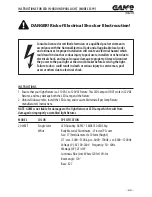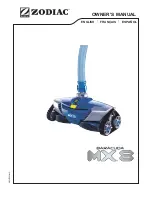
P o w e r D e f e n d e r 1 4 0 f o r W a t e r w a y P o o l P u m p M o t o r
I n s t a l l a t i o n a n d O p e r a t i o n M a n u a l
1
Important Safety Information
·
Read all instructions thoroughly and be familiar with the equipment before installing or working on it.
·
Before connecting or disconnecting cables or other electrical connections, verify that electrical
power to the system is removed. Failure to comply may cause serious damage to the pool pump
motor or injury.
·
Because of the risk of electric shock, only individuals thoroughly trained in the use of multimeters
should conduct voltage tests.
·
Never touch the metal contacts on the multimeter during a test.
·
Always check testing equipment for proper operation before use.
Installation, operation, and maintenance must be performed by qualified personnel. Familiarization with
and adherence to the National Electrical Code (NEC), National Fire Protection Association (NFPA)
standards and to local codes are required. It is important to observe safety precautions to protect
personnel from possible injury. Personnel should be instructed for handling each of the following:
·
Only apply nameplate voltage (115 or 230) with the Voltage Selection Switch in the correct position.
·
Insulate all connections carefully to prevent grounding or short circuits. Reinstall all conduit and
terminal box covers.
·
To avoid overheating or loss of output power, voltage to the motor control unit must be within plus
or minus 10% of the nameplate voltage.
·
Make sure the unit is electrically grounded and that proper electrical installation, wiring, and controls
are used consistent with local and national electric codes. Refer to
NEC Handbook
and
NFPA No.
70
. Employ qualified electricians for the installation and maintenance of the unit.
·
Code requirements differ from state to state. Install equipment using qualified electricians
in accordance with the applicable codes and ordinances in your area and in accordance with NEC.
All electrical connections should be made and maintained by a qualified or licensed electrician.
·
Make sure there are no unusual noises or vibrations when the motor is running.
·
Avoid contact with energized circuits and rotating parts.
·
Provide proper safeguards for personnel against rotating parts.




































